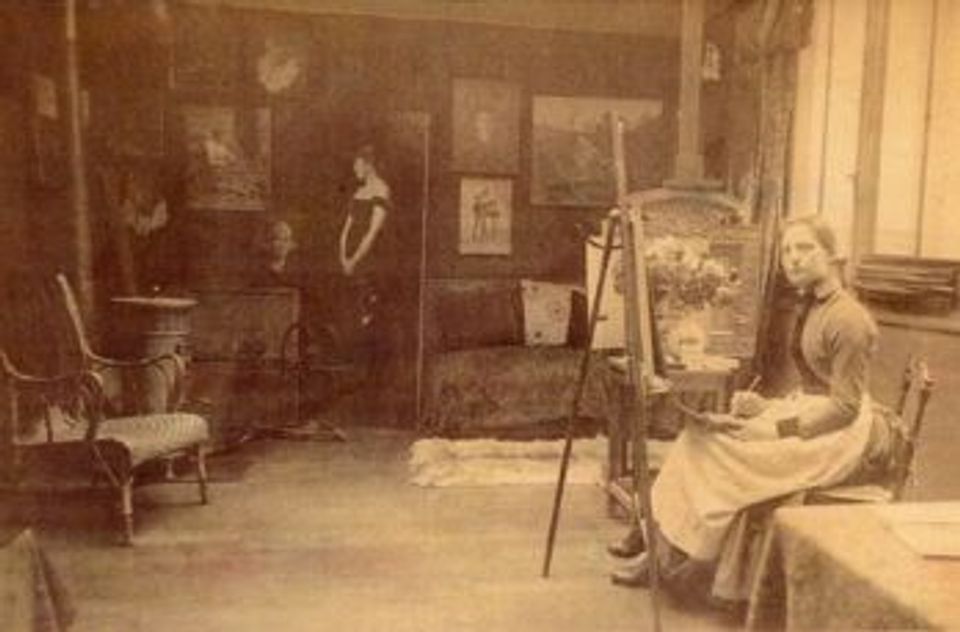Elizabeth Nourse

- Born
- Mount Healthy, Ohio, United States
- Died
- Paris, France
- Active in
- France
- Cincinnati, Ohio, United States
- Biography
- Elizabeth Nourse's considerable reputation as a Salon painter was acquired in Paris during the late nineteenth and early twentieth centuries, when that city was the leading international art center. Nourse was acclaimed by her fellow artists and the public alike, not only for her technical skill but also for the unique personal vision she brought to her subject matter.
She was one of the first American women to be elected a member of Société Nationale des Beaux-Arts, and she won many awards in the international expositions of the time, in Chicago, Nashville, Paris, Saint Louis, and San Francisco. She was consistently invited to enter the annual juried exhibitions that were a prominent feature of the American art scene—at the Pennsylvania Academy of the Fine Arts, the Carnegie Institute, the Art Institute of Chicago, the Cincinnati Art Museum, and the Corcoran Gallery of Art. As a final accolade the French government bought her painting Les volets clos for its permanent collection of contemporary art to hang in the Musée du Luxembourg with the work of such artists as James Abbott McNeill Whistler, Winslow Homer, and John Singer Sargent.
Nourse's career parallels that of other expatriate artist of the pre-World War I period, but certain aspects of it are unique. With Mary Cassatt and Cecilia Beaux, she was one of the few women painters to achieve international recognition for her work and, like them, faced certain obstacles that a male artist did not encounter. She first had to prove that she was a serious professional since most women painters, now matter how gifted, were considered "Sunday painters" who would eventually marry or become teachers and fail to produce a significant body of work. To acquire professional status she had to be recognized by the all-male juries of the Salons and international exhibitions and to be favorably reviewed by the art critics, who also were mostly men. As a Victorian lady she could not easily advance her career by forming friendships in these groups, as a male artist could; the social interchange of the café, so much a part of the artistic life of Paris in her day, was denied to her. To compensate for these disadvantages, she always had the total support of her family and of a large network of women friends who admired her work, publicized it, and bought it.
Unlike Cassatt, Nourse did not have an independent income nor did she teach, as Beaux did. Yet from 1883 until her death in 1938, a period of fifty-five years, she earned her living as a professional artist and supported her older sister, Louise, as well. She was also unusual among both men and women expatriates in being almost entirely American trained. Except for a few months' study in New York and later in Paris at the Académie Julian (where critics told her she needed no further schooling), her style was formed at the McMicken School of Design in Cincinnati.
When Nourse went to Paris in 1887 it was the Mecca for all aspiring young artists who hoped to refine their drawing techniques and to absorb the newest ideas in the contemporary art world. French academic training centered on drawing from the nude, and Nourse could already draw a convincing figure when she arrived. …
Nourse had not only developed an individual technique before she went to Paris but had also found her subject matter. Her interest in the peasant themes so popular among the Salon painters of her day was simply an extension of her preoccupation with the simple subjects she had painted in the Midwest—the daily routine of rural folk, especially women at work, mothers and children, portraits of [African American] women and girls, and country landscapes.
Like every memorable artist, Nourse was able to express in her work an original personal vision that is immediately evident to the viewer, who may know nothing about her life. Her biography explains, however, why she brought such deep conviction to her portrayal of working people, particularly to women; to the importance of motherhood; and to the beauty found in the simplest aspects of daily life and of nature. These subjects, banal in the hands of someone less sincere and less skilled, reflected her basic values and Nourse was able to infuse them with a special sense of their importance and their universal meaning.
Mary Alice Heekin Burke and Lois Marie Fink Elizabeth Nourse, 1859–1938: A Salon Career (Washington, D.C.: Smithsonian Institution Press for the National Museum of American Art and the Cincinnati Art Museum, 1983)
- Luce Artist Biography
Elizabeth Nourse was raised in a Catholic family in Cincinnati. Her father was a successful banker until the Civil War wiped him out. The women in the family learned skills that would allow them to support themselves. Elizabeth took classes in painting and sculpture as well as wood carving, china painting, and engraving. After she completed her studies, she sold pen and ink drawings of local homes, made illustrations for magazines, and created mural decorations. When they had saved enough money, Elizabeth and her older sister rented a studio on Paris’s Left Bank, and Elizabeth enrolled in the prestigious Académie Julian. She was ambitious, and after only three months set to work on a painting for the Paris Salon. This bold move paid off when her finished work was accepted by the jury and placed in a prime spot at eye level. She remained in Paris for the rest of her life. (Burke, Elizabeth Nourse, 1859-1938: A Salon Career, 1983)













